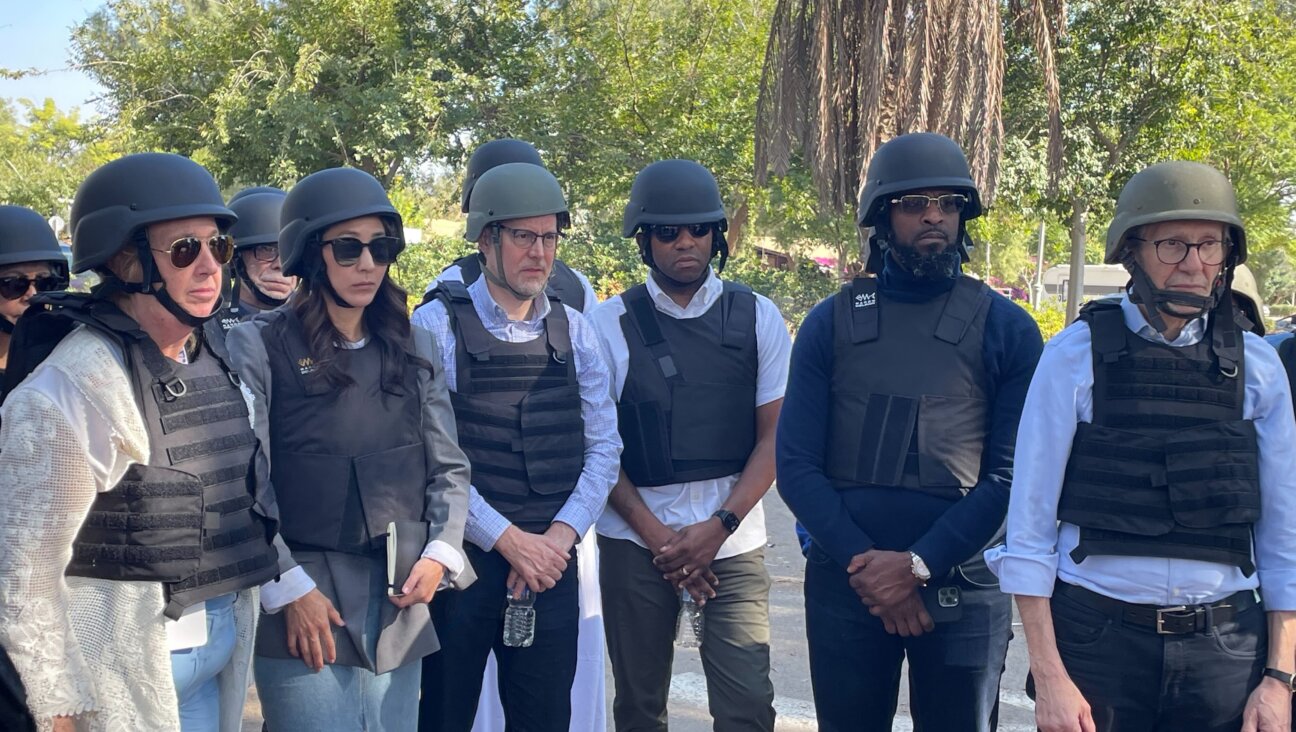The 1990s: The Illusion of Peace

Graphic by Angelie Zaslavsky
In the history of the State of Israel, the 1990s were the time of the Palestinians. The decade began with a Palestinian intifada and ended with a second Palestinian intifada, deadlier and more vicious than the first. Between the two waves of violence, Israel was swept like a roller coaster from the heights of euphoria to the depths of despair, from mania to depression, from ornate peace ceremonies on the White House lawn to mass terrorist attacks, from a dangerous rift between left and right to the murder of a prime minister.

UNDER ATTACK: Iraqi Scud missiles fell on Tel Aviv during the first Gulf War in 1991. Many Israelis fled their homes.

NEW ARRIALS: A wave of immigration from the former Soviet Union changed the face of Israeli society.
During the 1990s the Palestinian problem was transformed from a theoretical, almost sterile discussion into an existential Israeli problem.
This statement calls for some clarification. In 1967, Israel defeated the armies of Egypt, Jordan and Syria. The Palestinians were not combatants; they raised white flags on the roofs of their houses and waited contritely for the conqueror.
With time, the notion took root in Israel that the Palestinians had no central role to play in the struggle over the future of the territories Israel had captured. They could hijack an airplane or plant a bomb on a downtown Jerusalem street, they could whip up crowds in Arab capitals and attract media attention, but they couldn’t shake Israel’s hold on the territories.
The debate within Israel over the future of the territories was considered an argument between Jews: The right called for settlement of every open spot in the West Bank and Gaza, while the left protested the evils of the occupation. The Palestinians were not a party to this debate.
Hundreds of thousands of Palestinians went out every day from their homes in the territories to the towns and villages of Israel to work as house cleaners, dishwashers, construction workers, auto mechanics and farm laborers. Many of them spent their nights in rented rooms in the poorer sections of Israel’s main cities. In 1988, I was the editor of a weekly magazine with offices in a building in south Tel Aviv. One of the women who worked at the paper was caught in her car one night in an empty lot near the office. Dozens of Palestinians suddenly appeared out of nowhere, like a scene out of Tom Wolfe’s “The Bonfire of the Vanities.” They were the residents of improvised shacks and abandoned buildings scattered on the lot whose existence had escaped our notice until that moment.
“The Yellow Wind,” by Israeli author David Grossman, had appeared in our magazine in serialized form a year before Palestinian uprising began; it foretold the uprising’s outbreak. The book became a bestseller. Responding to public demand, we hosted an evening in a Tel Aviv theater to acquaint our readers with Palestinians who appeared in the book. One of the guests was a Palestinian laborer who had been living for years under a stairwell in an affluent Tel Aviv apartment building. He described, in fluent Hebrew laced with sarcasm, his impressions of the neighbors who never noticed him. The audience members, most of them middle-class liberals, were shocked. They had been certain that the Palestinian problem was contained in the territories.
The 1990s exploded this unstable coexistence. The Palestinians won recognition, first as an enemy, then as a partner, then as a partner-cum-enemy and finally, in 2000, as a fully fledged enemy. The question of whether this was inescapable fate or human error, of who was to blame and why, remains an open wound in parts of Israeli society to this day. Elements on the right speak of the “Oslo criminals,” referring to the Rabin and Peres governments that served from 1992 to 1996. Elements on the left hurl back epithets, like “murderers of peace,” at the Netanyahu government, which served from 1996 to 1999.
Five prime ministers served in Israel during those years, far too many even in countries whose leaders must make decisions that are far less fateful. Each one embodied in his own way the dilemmas that wracked Israel throughout the decade.
Yitzhak Shamir was 75 in 1990. A radical and revolutionary in his youth, he had matured into a staunch conservative. “The Jewish people,” he used to say, “has gone through enough revolutions for one generation. It has experienced the Holocaust, the establishment of Israel and all its wars. It doesn’t need another revolution.” For Shamir, this was not mere rhetoric but an entire worldview. He didn’t have much in the way of charisma, but he did possess a strong character and nerves of steel, important qualities in a nation locked in war.
Early in 1990, Shimon Peres, Shamir’s deputy in the national unity government, tried to unseat him in what Yitzhak Rabin called the “stinking maneuver.” The maneuver failed, and Shamir survived as prime minister in a narrow government of the right. Within months, Israel was caught in someone else’s war. When the coalition of nations led by the United States went to war with Iraq in response to Iraq’s invasion of Kuwait, Saddam Hussein responded by firing his Scud missiles at Israel. The damage was minor, but the shock was enormous. For the first time since the 1948 War of Independence, the battlefield had moved to Israel’s home front. Hundreds of thousands of Israelis fled their homes and moved to the periphery. The fear was great, and so was the frustration.
Elements in the defense establishment pressured Shamir to attack Iraq. He refused. He didn’t believe that Israeli military engagement would reduce the missile threat. It would only hinder the Americans’ conduct of their war against Iraq and bring them into confrontation with Israel afterward. And Shamir was right.
After the war, a victorious America sought to translate its gains in Iraq into leverage for an Israeli-Arab peace accord. Shamir didn’t believe there was any possibility of an accord. More to the point, he didn’t want to pay the price. He was forced into a confrontation with Secretary of State James Baker, a ruthlessly ambitious lawyer. Baker wanted to convene a Middle East peace conference, and the conference was indeed convened. Shamir was dragged there unwillingly.
The Madrid conference brought neither peace nor reconciliation. What it did provide was a stage for a propaganda war between Israel, represented by the brilliant rhetoric of Benjamin Netanyahu, and the Palestinians, represented no less brilliantly by Hanan Ashrawi. The main achievement of the Madrid conference was the fact that it took place.
In 1992, Shamir’s Likud lost a parliamentary election. Rabin became prime minister. The Rabin of 1992 was in many ways the antithesis of his predecessor. He entered the job full of adrenalin, certain of his ability to bring about change in Israel’s relations with the Arab world, within Israeli society and in the lives of individuals. When he promised just before the election to sign a peace treaty with an Arab party within 10 months, he was thinking of Syria. But Syria’s president, Hafez al-Assad, hesitated and dragged his feet, and in the end he sank the negotiations. Rabin was left with no alternative but to reconsider the Palestinian front. In Washington, Madrid follow-up talks were under way between second-tier Israelis and Palestinians from the territories, the latter of whom were secretly taking orders from Yasser Arafat in Tunis.
The talks were going nowhere. Within Rabin’s Labor Party, calls were mounting for Israel to recognize the Palestine Liberation Organization. Rabin feared a party mutiny, led from behind the scenes by his foreign minister and bitter rival, Peres.
In 1993, Rabin succumbed to the inevitable. He entered the Oslo process like a basketball player guarding his rear. But the process was stronger than he was. The huge enthusiasm it evoked around the world, the expectations it aroused in Israel, the Israeli domestic political battle that was verging on civil war — all these circumstances conspired to put him in a position that he had never occupied in his long career as a soldier and statesman: advocate and icon of peace.
Oslo was a failure. More precisely, perhaps, it was a heroic failure, a case of good intentions foiled by a bad reality. The matter of who was responsible for the failure remains an open question: whether there was an unbridgeable gap from the outset between the declared positions of the two sides and their actual intentions and behavior on the ground, whether the accord’s phased steps toward peace doomed it to failure, whether the assassination of Rabin and the victory of the Likud party in 1996 killed any chance of peace — or whether there never was any chance to begin with.
Oslo bore secondary fruits whose value must not be overlooked. Thanks to Oslo, Rabin was able in 1994 to sign a peace treaty with Jordan. The Arab world was opened for the first time to Israeli diplomats, entrepreneurs and tourists. Most of the Arab contacts eventually flickered or went underground, but the Arab boycott died and Israel found itself thrust all at once into the heart of the global economy. Within a matter of months, 120 multinational corporations entered into business deals with Israel.
Yasser Arafat returned to the territories in 1994 after 16 years’ absence, and this time under Israeli auspices. When he crossed the border at Rafiah, his vehicle was carrying smuggled weapons. The Israelis, who had hoped to see in Arafat a Palestinian version of David Ben-Gurion — a politician who would know how to shape his powers as a leader into the responsible molds of statecraft — discovered to their alarm that he was still the same old Arafat.
And the Palestinians learned that Israel was still the same Israel. Even as it negotiated peace, it was stepping up the pace of settlement in the territories. The Israeli government was torn between conflicting political imperatives. The occupation was not over. In many senses it became less comfortable, mainly because of the security problems that resulted from the presence of armed PLO forces in Gaza and the West Bank.
Terrorism returned, first in small, manageable doses and then in gradually increasing waves. Rabin, who had believed that Arafat would halt terrorism — if not out of concern for Israel then at least to secure his rule — discovered that Arafat was using terrorism for his own purposes. Rabin tried to hold the stick at both ends, to fight terrorism as though there were no Oslo and pursue Oslo as though there were no terrorism. Peres, his successor, tried to do the same thing. The results were frustrating.
The assassination of Rabin in November 1995 was every bit as traumatic as the assassination of John F. Kennedy in its day, if not more so. It called into question not just the stability of the Israeli state and the ability of Israeli society to settle its internal differences in a democratic fashion, but also the very idea of solidarity among Jews. There had been an unwritten compact among all the streams of Israeli politics, forged in the early years of the state and reinforced through years of common battles against external enemies, that however bitter the debates might become, assassination was beyond the pale.
Israel has no written constitution. What has preserved it as a genuine, vibrant democracy was respect for the rules of the game. Yigal Amir, Rabin’s assassin, cast doubt on the viability of the rules of the game.
Peres was the first to feel the impact of this new doubt. His brief term as prime minister — just seven months — was characterized mainly by paralysis. Peres came into the prime ministry after passing through every shade of Israeli opinion. He was in the right wing of the Labor Party at one time and the left wing at another. He was the patron of the settlements in the 1970s and the apostle of peace in the 1980s. For much of his life his path was marked by his feud with Rabin. Sometimes he was trying to hold Rabin back, at other times to drag Rabin after him. Now he had no Rabin to feud with. He had lost his way.
In May 1996, in Israel’s first-ever direct elections for prime minister, Benjamin Netanyahu emerged the victor. Three years after the Oslo Accords was signed, it was put to the test of facing a hostile Israeli government. The difference was in goals: Peres wanted to bring the process to a happy ending, to reach a peace agreement between the Israeli government and a Palestinian government. Netanyahu wanted to minimize the damage. If he could, he would have pressed the “delete” key and buried the agreement between the pages of history. But he was too weak and too eager to play the game successfully. At one of their meetings, Arafat offered him a cigar. Netanyahu accepted it eagerly and proceeded to sit with Arafat, puffing happily away as though it were a peace pipe.
Netanyahu survived just three years as prime minister. He didn’t know how to meet the expectations of the right, nor to calm the traumas of the left. But his greatest difficulty was at the center of the political map: He couldn’t offer Israelis consistent, trustworthy, visionary leadership. His tenure was marked by petty, embarrassing scandals; corruption within the ruling party, and tensions with the American administration. Fears of a renewed outbreak of Palestinian violence kept the public on edge.
In May 1999, Netanyahu was defeated by Ehud Barak. Barak saw himself as the true heir of Rabin. Both Rabin and Barak came to politics after brilliant military careers, scarred by wars, culminating in terms as military chief of staff — a position of enormous prestige in Israel. Both men were born and raised in the bosom of the labor movement. Both were sworn hawks who knew the advantages and the limits of military power. Both of them believed that governing a country such as Israel is like riding a bicycle: If you don’t keep moving forward, you’ll fall. And both of them were intent on reaching a historic decision during their tenures; each of them believed that no one coming after him would be capable of reaching a peace agreement that could protect Israel’s security for generations to come.
But Barak was less focused than Rabin, and less experienced. Like Rabin, he tried to reach an accord on the Syrian front, and failed. This time the responsibility for the failure did not fall solely on Assad’s shoulders. Public opinion polls had convinced Barak that a majority of the Israeli public was opposed to a Syrian presence on the shores of Lake Kinneret. He balked at the price entailed in an agreement. When Assad was ready, Barak hesitated. When Barak was ready, Assad had taken sick. Assad devoted his final efforts to ensuring a smooth transfer of power to his son, Bashar.
During his election campaign, Barak promised to withdraw from Lebanon. Lacking a partner, he ordered a unilateral withdrawal. This was a brave decision. It removed a painful topic from Israel’s public agenda. Unfortunately, it removed it only temporarily. The Lebanon problem would return at full force in the coming decade.
Barak tried to advance an agreement with the Palestinians, while at the same time authorizing the army to prepare secretly for a new Palestinian intifada. The military preparations undermined efforts to improve daily Palestinian living conditions in the territories and to progress toward an agreement.
In the end, Clinton and Barak dragged Arafat to Camp David for a summit billed as a last-ditch attempt at peace. The terms that Barak offered Arafat were generous, even bold when measured against the expectations of Israeli public opinion: He offered at least 90% of the territory, including Arab neighborhoods in East Jerusalem. When Arafat refused to discuss details, Barak improved the offer. He behaved as though he had no red lines.
Barak thought he was operating in a win-win situation: If he returned from Camp David with a peace agreement, he won; if he returned with a failure for which Arafat alone was blamed, he still won. When it was over, though, he found he was in a lose-lose situation. He had lost his support on the Israeli left, and the right unleashed a torrent of hostility. Even worse, the breakdown at Camp David paved the way for a wave of terrorism the likes of which Israel had never known.
Palestinian terrorism had been a central factor in the victory of Rabin over Shamir in 1992. Shamir had been perceived as helpless in the face of terrorist attacks and the rioting that followed. Terrorism also played a decisive role in the defeat of Peres in 1996 (or so Peres told me, with considerable justification), and terrorism led to the defeat of Barak and the victory of Ariel Sharon in 2001.
Terrorism robbed Israeli society of the dreams it had nurtured since 1967. The dream of a Greater Land of Israel, in which, as Jabotinsky once wrote, “the son of Araby, the son of the Nazarene and my own son will dwell in happy accord” — the dream, in other, more contemporary words, of an enlightened, magnanimous Israeli occupation ruling over the Palestinians forever — was no more.
The dream of peace, which had assumed that if only Israel withdrew from most or all of the territories, dismantled settlements and allowed the Palestinians to establish a state of their own, then the two nations could live side by side in comfort and joy — that dream, too, collapsed. When Israel unilaterally withdrew its settlements from Gaza and pulled its troops back to the old border, Hamas took over Gaza and the nearby towns in Israel proper found themselves subjected to daily rocket bombardment.
Terrorism caused even worse damage to Palestinian society. It drove away investors who had come into the territories in the wake of the Oslo Accords. It prompted a mass exodus of anyone with the means to leave. The middle class was destroyed. Anarchy and rage ruled the Palestinian cities. The justice system collapsed. Generations of young Palestinians gave over their futures, and sometimes their lives, to Islamist terrorist organizations.
Israel survived, and in many senses it emerged stronger. One million immigrants, the majority of them from the lands of the former Soviet Union, a minority from Ethiopia and the West, came to Israel and were absorbed into Israeli society. It was one of the most successful immigration waves the state had ever known. The immigrants wrought dramatic changes in the atmosphere of the development towns and outlying settlements. They contributed mightily and brought real advances in the fields of education, culture and high-tech.
Looking back, eight years after the decade’s close, the 1990s appear as a series of experiments, some of them bold and far-reaching, to change the state of affairs between Israel and its neighbors. The experiments failed, but along the way they clarified the parameters of any future settlement. The central problem seems to be finding a partner, not deciding on the borders.
The bad news is that the very existence of the State of Israel has been called back into question. At the beginning of the decade, between one peace ceremony and another, between one summit and another regional conference, Israelis began to feel that they were finally a part of the region they lived in. By the end of the decade, they had good reason to fear that they were living, as they had in the 1950s, with their backs against the sea.
Nahum Barnea is a senior political columnist with Yediot Aharonot, Israel’s largest-circulation daily newspaper.























